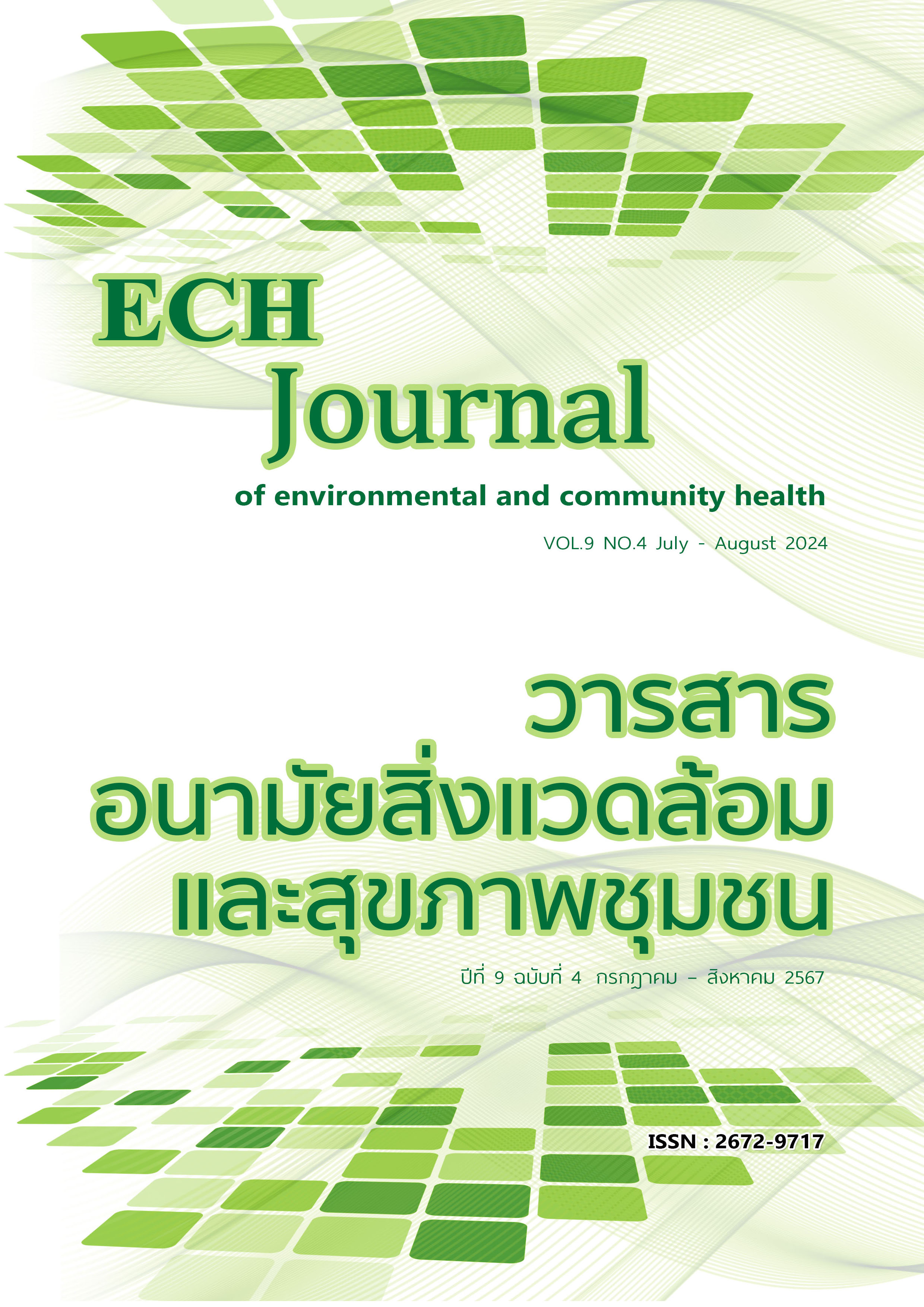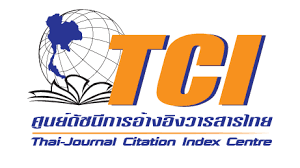THE DIETARY BEHAVIOR MODIFICATION FOR REDUCING SALT AND SODIUM AMONG THE RISK OF HYPERTENSION, UDON THANI PROVINCE
Keywords:
Behavioral modification, Low-sodium diet, High-risk hypertension groupAbstract
The quasi-experimental research aimed to compare the knowledge and sodium salt consumption behaviors in food among individuals at risk for hypertension and to evaluate the estimated sodium content in their diet. The sample consisted of 105 individuals who were purposefully selected. The research instruments included: 1) activities designed to modify sodium consumption behaviors, 2) a questionnaire assessing knowledge about consuming high salt and sodium foods, and 3) a behavior assessment questionnaire regarding high salt and sodium food consumption. The validity of the instruments was confirmed with IOC 0.67 - 1.00, The reliability were 0.82 and 0.80, respectively. 0.82, and 0.80. respectively. The research was conducted from April to June 2024, over a period of 12 weeks. Data were analyzed using descriptive statistics and comparative statistics with pair t-tests.
The findings revealed that the majority of the sample was female (69.9%), with an average age of 56 years, ranging from 36 to 91 years. Most were farmers (34.28%) and had a primary education level (77.73%). A significant portion (66.7%) were suspected of having hypertension. The average knowledge score regarding high salt and sodium food intake before participating in the behavioral modification program was moderate (𝑥̅=10.15, SD=1.65), which significantly increased to a high level after intervention (𝑥̅=13.28, SD=1.30) (p-value = 0.00). The average cooking behavior score improved from a moderate level before the program (𝑥̅=2.25, SD=0.50) to a good level after the program (𝑥̅=2.54, SD=0.53) (p-value = 0.00). Comparing the average systolic blood pressure before and after the behavioral modification program showed a significant reduction from 138.4 mmHg (SD=6.42) to 122.9 mmHg (SD=6.35) (p-value = 0.00). Similarly, the average diastolic blood pressure decreased from 81.73 mmHg (SD=7.81) to 75.94 mmHg (SD=7.41) (p-value = 0.00). The mean salinity of the foods was 0.674% (SD=0.26), which was significantly reduced by 0.959 % (SD=0.38) (p-value = 0.00).
References
ธิดารัตน์ อภิญญา.รายงานผลการทบทวนรูปแบบการดาเนินงานป้องกันโรคไม่ติดต่อในวิถีชีวิตด้วยการลดการบริโภคเกลือ. กรุงเทพมหานคร:โรงพิมพ์องค์การสงเคราะห์ทหารผ่านศึก; 2556.
World Health Organization. Global statusreport on noncommunicable diseases2010.Geneva: World Health Organization; 2011.
สำนักงานพัฒนานโยบายสุขภาพระหว่างประเทศ. รายงานภาระโรคและการบาดเจ็บของประชากรไทย พ.ศ. 2552. นนทบุรี: สำนักงานพัฒนานโยบายสุขภาพระหว่างประเทศ; 2555.
กาญจนา มณีทัพ, และ สมจิต แดนสีแก้ว. สถานการณ์การบริโภคเกลือของผู้ป่วยความดันโลหิตสูงจังหวัดขอนแก่น. วารสารการพยาบาลและการดูแลสุขภาพ. 2560,35(4), 139-49.
สำนักสถิติแห่งชาติ. การสำรวจพฤติกรรมการบริโภคอาหารของประชากร พ.ศ. 2560. กรุงเทพฯ: สำนักงานสถิติแห่งชาติ. 2561.
World Health Organization. Global Action Plan for the Prevention and Control of Noncommunicable Diseases 2013-2020. Geneva: World Health Organization. 2013.
กองตรวจราชการกระทรวงสาธารณสุข. สรุปการตรวจราชการกระทรวงสาธารณสุขเขต 8 อุดรธานี รอบ 2/2566. [cited 2024 March 06]: https://inspection.moph.go.th/e inspection/public/visit.php?id_area=M213cVNYOXprZXpzNFlsaENlYWxkZz09
สำนักงานสาธารณสุขจังหวัดอุดรธานี. เอกสารประกอบการตรวจราชการและนิเทศงาน กรณีปกติ จังหวัดอุดรธานี รอบที่ 2 ปีงบประมาณ 2566. อุดรธานี. 2566.
กองสุขศึกษา กรมสนับสนุนบริการสุขภาพ กระทรวงสาธารณสุข. แนวทางการดำเนินงานปรับเปลี่ยนพฤติกรรมสุขภาพ ระดับจังหวัด. กระทรวงสาธารณสุข นนทบุรี 2565.
Irwan, AM. et al. Development of the salt reduction and efficacy-maintenance program in Indonesia. Nursing and Health Sciences, 2016.18:519–532.
Pender, N. J., Murdaugh, C. L., & Parsons, M. A. Health promotion in nursing practice.(4th ed.) New Jersey: Pearson Education, 2002.
Faul, F., Erdfelder, E., Lang, A.-G., & Buchner, A. G*Power 3: A flexible statistical
power analysis program for the social, behavioral, and biomedical sciences. Behavior Research Methods, 2007. 39, 175-191.
กองโรคไม่ติดต่อ กรมควบคุมโรค. คู่มือการสำรวจปริมาณโซเดียมในอาหารด้วยเครื่องวัดความเค็ม (Salt Meter) 2565. [cited 2024 March 06]: https://ddc.moph.go.th/uploads/publish/1238320220301081354.pdf
Bloom, B.S. Handbook on formative and summative evaluation of student learning.New York: McGraw–Hill. 1971.
บุญชม ศรีสะอาด.การวิจัยเบื้องต้น. กรุงเทพฯ : สุวีริยาสาส์น, 2545.
Nakano M, et al. Effect of Intensive Salt-Restriction Education on Clinic, Home,and Ambulatory Blood Pressure Lavels in Treated Hypertension Patients Druing a 3-Month Education Period. Journal of Clinical Hypertension [Internet]; 2016 [cited 2024 March 06]: 18(5):385392. Available from: Doi: 10.1111/jch.12770.
Ferrara LA, et al. Lifestyle Education Program Strongly Increases Compliance to nonpharmacologic intervention in Hypertension patient: A2-Year Follow-Up Study. Journal of Clinical Hypertension [Internet]; 2012 [cited 2024 March 10]; 14(11):767-772. Available from: Doi: 10.1111/jch.12016.
Dahl LK. Possible role of salt intake in the development of essential hypertension. In: Cottier P, Bock D, editors. Essential hypertension-an International Symposium. Berlin: Springer-Verlag; 1960
Taylor RS et al. Reduced dietary salt for the prevention of cardiovascular disease: a meta-analysis of randomized controlled trials (Cochrane Review). American journal hypertension [Internet]. 2011 Aug [cited 3 March. 2024];24(8):[about 843-53
พรทิพย์ นิ่มขุนทดและคณะ. ความสัมพันธ์ระหว่างพฤติกรรมการรับประทานอาหารเค็มกับโรคความดันโลหิตสูง และโรคหัวใจและหลอดเลือด. โครงการวิจัยมหาวิทยาลัยเทคโนโลยีสุรนารี. 2560, 33.
Bureau of Non-Communicable Diseases, Department of Disease Control, Ministry of Public Health. Implementation guidelines for reducing salt and sodium consumption at the provincial level. Nonthaburi: Bureau of Non-Communicable Diseases, Department of Disease Control; 2023.





